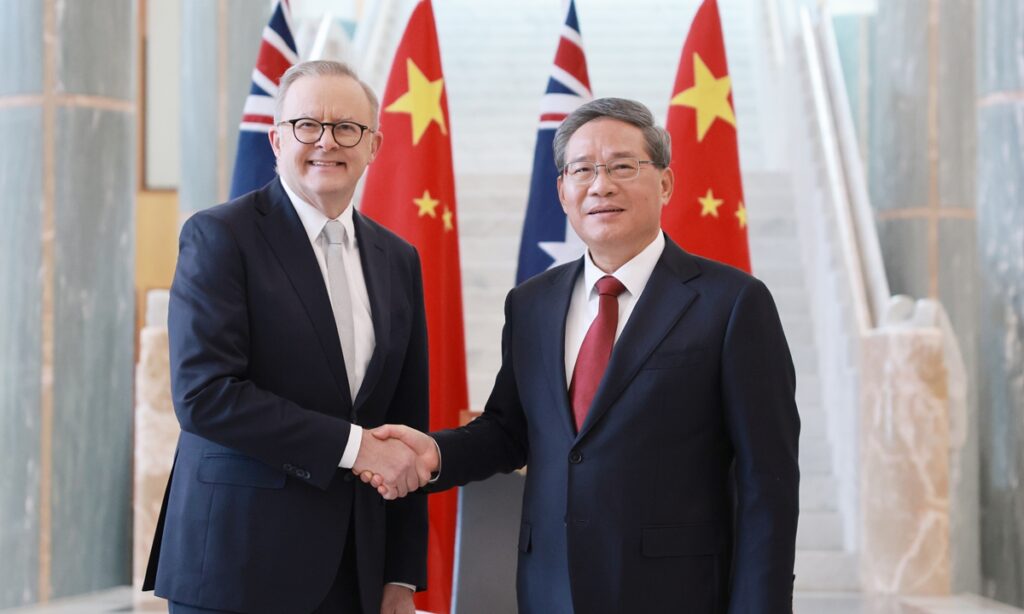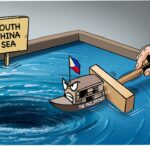Two countries to expand cooperation in new energy vehicles, renewable energy power generation
Chinese Premier Li Qiang said Monday that China is ready to work with Australia to build a more mature, stable and fruitful China-Australia comprehensive strategic partnership to better benefit the two peoples. Li also announced on Monday that China will include Australia on the list of unilateral visa-free countries.
The premier’s visit to Australia has showcased China’s sincerity in improving ties with Australia, and it is hoped that Australia will meet China halfway to allow for the evolution of bilateral relations and increased cooperation, said observers.
Looking back at the development of China-Australia relations over the past decade, the most important experience and inspiration is to uphold mutual respect and mutually beneficial cooperation, and seek common ground while shelving differences, Li said.
Li made the remarks during the ninth China-Australia Annual Leaders’ Meeting with Australian Prime Minister Anthony Albanese.
Since Prime Minister Albanese’s visit to China last November, China and Australia have further restored and developed dialogues and cooperation in various fields, achieving a comprehensive turnaround in bilateral relations, Li said.
He said China is willing to work with Australia to maintain and develop the current hard-won positive momentum of bilateral relations.
Li also expressed the hope that the Australian side can provide a fair, just and non-discriminatory business environment for Chinese enterprises, and provide more convenience for personnel exchanges between the two sides.
China is willing to enhance coordination and cooperation with Australia at regional and international levels, oppose bloc confrontation and a “new Cold War” from the perspective of maintaining regional peace and stability, adhere to openness, inclusiveness and common development, and work together to advance regional economic integration and build an open world economy, Li said.
China is willing to stick to its comprehensive strategic partnership with Australia, give full play to the China-Australia Strategic Economic Dialogue and other mechanisms, continuously boost trade, actively expand cooperation in new energy vehicles, renewable energy power generation and other fields, and strengthen sub-national, cultural and tourism exchanges and cooperation, he said.
Li said on Monday that China will include Australia in the list of unilateral visa-free countries.
Albanese said that Australia is pleased to see that current Australia-China relations are stabilizing and improving. Australia adheres to the one-China policy and does not support “Taiwan independence.”
A Statement on Joint Outcomes of the China-Australia Annual Leaders’ Meeting was released on Monday. It reaffirmed mutual respect, equality, mutual benefit, stable development and Australia’s commitment to the one-China policy. They agreed to continue to grow the bilateral relationship and uphold their respective national interests. They also agreed that both sides would continue to navigate their differences wisely.
More than stabilizing
The joint statement acknowledged the importance of regular engagement between leaders, ministers and officials on both sides in support of the ongoing stabilization and development of the bilateral relationship. They confirmed plans to resume the Strategic Economic Dialogue in 2024.
The dialogue was suspended in 2021 on the heels of downward spiraling bilateral relations.
China has released enough goodwill during the premier’s visit to Australia, including rolling out preferential visa policies for Australian nationals and restarting the China-Australia Strategic Economic Dialogue, Ning Tuanhui, an assistant research fellow at the China Institute of International Studies, told the Global Times.
It is fair to say that China has demonstrated a positive attitude in improving collaboration at all levels, highlighting the importance Beijing attached to this visit and improving ties with Australia, said Ning.
On the other hand, Canberra has also come to realize that its previous strategy of using twisted microphone diplomacy to smear China not only led to a significant deterioration in bilateral relations but also had negative repercussions on its own economy, according to Chen Hong, director of the Australian Studies Center at East China Normal University. He believes the pragmatic approach taken by the current Australian government will be conducive to enhancing cooperation.
This dialogue has “allowed us to build a deeper awareness of our respective interests,” Albanese said, noting Australia and China had complementary economies and shared interests in addressing climate change.
On Monday, leaders of the two countries witnessed the signature of MOUs on Education and Research, Climate Change, the China-Australia Strategic Economic Dialogue, Further Enhancing the Implementation of China-Australia Free Trade Agreement, and the 15th Implementation Program for Cultural Exchanges for 2024-2027 under the 1981 Agreement on Cultural Cooperation.
Both leaders welcomed the implementation of arrangements to facilitate exchanges, including reciprocal access to multi-entry visas of up to three to five years’ duration for business, tourism, and visiting family members.
Stabilization alone is insufficient to characterize the future of China-Australia relations. As the bilateral relationship continues to evolve, progress is necessary. China is committed to advancing such progress, and it is hoped that Australia will also demonstrate strategic prudence and political wisdom in meeting China halfway, according to Chen.
Common interest
Divergences still exist despite that the bilateral ties are warming up. Albanese told reporters in Canberra that “one of the very practical measures that we spoke about was improving military to military communication so as to avoid incidents.”
In May, Australia claimed that a Chinese Chengdu J-10 fighter jet released flares in the flight path of an Australian navy Seahawk helicopter deployed from the Australian air warfare destroyer HMAS Hobart. Later, China’s Ministry of Foreign Affairs spokesperson said the truth is that an Australian military aircraft deliberately flew within close range of China’s airspace in a provocative move that endangered China’s maritime and air security in the name of enforcing UN Security Council’s resolutions.
In the joint statement released on Monday, both leaders agreed to continue or expand engagement in political dialogue, including through the Defence Strategic Dialogue and Defence Coordination Dialogue, and convening an initial session of a bilateral Maritime Affairs Dialogue.
Disputes on military, human rights, South China Sea are the long-existing divergences between China and Australia, said Ning. He believes such differences will continue to exist as the US is pushing for its Asia-Pacific strategy, with Australia being the core member of all US-led small cliques in the region, including AUKUS and QUAD.
China has always opposed Australia’s joining of those groups; thus how to develop relationship with China while answering to US pressure remains a difficult task for Canberra in the future, said Ning, noting that it is a positive sign that both side agreed to have dialogue on military level.
Beijing and Canberra share a common interest in defending the peace and stability of the Asia-Pacific region. Chen stated that turmoil in this region would harm the interests of both countries. Therefore, they should make joint efforts toward this goal instead of serving the interests of extraterritorial countries.
Global Times




